2023



2023


GREG
The Chicago Transit Authority is in desperate need of an overhaul. PAGE 2
 BY STEVE HENDERSHOT
BY STEVE HENDERSHOT

Chicago is supposed to have a City Council with the strength and independence to check the mayor’s power, but also one that’s attuned and responsive to the concerns of its citizens.

In fact, the council already has the authority to chart the city’s course and the structure to facilitate more neighborhood-level engagement than any other big U.S. city — each council member represents 53,931 residents, a dramatically smaller ratio than exists in any other of America’s 10 largest cities.
Yet in practice, Chicago’s mayors wield astounding power, both in absolute terms and relative to the way authority is theoretically allocated by the city’s municipal code and state law. Rather than contributing meaningful block-level insights
to citywide policy discussions, Chicago’s legislators historically have instead focused on tending to ward services while deferring to the mayor on larger issues. In a vacuum, you can argue it’s a workable system. But in reality, the city has a century-long reputation as a corruption hotbed. It’s weighed down by a nancial mess tied to underfunded pensions that’s both more severe than most other cities’ pension woes and that stems from
As Chicago grapples with how to feed and shelter migrants now arriving daily, food pantries have stepped up to ll a void that some blame on the city’s failure to adequately prepare for the surge in hungry newcomers.
Already stretched by increased demand and rising in ation, pantries now face the challenge of feeding and caring for migrants seeking help at their doors.



“ ere are so many pantries that are really strained right now,” said Kellie O’Connell, CEO of Nourishing Hope, formerly Lakeview Pantry. “When I talk to my peers we’re all trying to meet the increased need but it’s pretty tough right now.” Nourishing Hope also operates another food pantry in Humboldt Park called El Mercadito.
FOODREAL
I spent some time the other day reading through the Chicago Police Department’s digital crime dashboard, which lists every crime reported to CPD. Even though I was examining only one seven-day stretch, May 16 to 22, it took a good hour to pull out what I was looking for: reports speci cally dealing with the Chicago Transit Authority.
I found more than 60 reported crimes on CTA buses and trains and at stations in that seven-day period. Included were four di erent assaults on CTA personnel, armed robberies, and attacks with guns and knives. No homicides, mind you, but the clear majority of the 60 involved violent o enses such as battery and worse.
So it goes lately with a transit system that should be an envy to other cities and a competitive advantage against Sun Belt towns but instead just can’t pull out of a horrible stretch that began with the COVID
pandemic and certainly is outlasting it. Mayor Brandon Johnson has lots of things on his plate right now. Unfortunately, xing the CTA needs attention, too.
Now, I don’t want to say the folks at the CTA aren’t trying. ey are.
ere are some signs of progress, and Chicago certainly isn’t alone in its misery. Just look at San Francisco’s BART system, which according to one recent report is carrying only 40% of its pre-pandemic number of passengers compared to the CTA’s 60% or so. at said, quicker, faster progress is needed. And equally large challenges are just down the track.
One problem is crime. e CTA says, based on CPD reports, that the number of reported crimes now is down 49% compared to pre-pandemic 2019, and “violent” o enses are up just a tad, only 4%, with unarmed private guards (though not police) making a di erence.
Given Mark Twain’s line about lies, damned lies and statistics, I’m not sure I buy it. But even if those numbers are correct, ridership is still barely half of what it was. So your chances of being a victim of a violent crime while using the system are up.
Beyond that, the CTA is having a dickens of a time dealing with quality-of-riding o enses that keep passengers away. Like smoking on vehicles. CTA says it’s handed out hundreds of citations, but the puers that abound on every third or fourth Red Line train I take seem to have missed the message. Similarly, though no one wants to mistreat homeless people who need help, shacking on a row of seats is just not humane or desirable for anyone. at leads to a related problem: frequency of service. e CTA now says trains and buses are running closer to schedule. at’s true.
According to Fabio Gottlicher at Commuters Take Action, an activist group that has begun using the CTA’s own data to track its performance, the number of trains now running averages “in the high 80s percentile” of what’s scheduled compared to around 70% before the agency trimmed its service. But because of a sta shortage, the number of trains and buses running remains about what it was a year ago, even as ridership starts to return. And at least 10% of those trains and buses never show — on average. On a given day and especially on the Blue Line, the wait can be interminable.
e next unsolved problem
amazes me: lth. e CTA insists it’s doing better now that warm weather is here. But in the State Street subway, the grime was so bad that signs warning passengers to stay o the track could not be read — for two whole years. At Roosevelt on the same line, a good number of the blue sound bu ers lining the walls are missing, and all are covered in dirt, which ts nicely with the crumbling ceiling and hole- lled concrete oor. e worst woe is yet to come. at’s what happens when huge federal COVID relief money drives up by late 2025.
See HINZ on Page 6
A quiet beer promised a peaceful ending to a tumultuous day, but a know-it-all with several pops already in him was spoiling for an argument.
“LeBron James or Michael Jordan?” he demanded, bellying up to a sparsely populated bar whose two TV sets carried the White Sox and Cubs.
No, he wasn’t Scottie Pippen o ering another myth-de ating, logic-defying MJ critique.
ere were half-hearted murmurings for Jordan, this being Chicago, but nobody seemed eager to engage. Mr. Bluster wasn’t dissuaded and began making a loud case for LeBron. I ignored him. “Era” arguments are as pointless as Pippen’s recent assertion that MJ was a “horrible” player — on what planet?
Sure, Babe Ruth dominated early baseball, with a color barrier rmly in place. So if there’d been a Bob Gibson or a Juan Marichal toeing the slab in his day, the Babe wouldn’t have faced him.
To put it in basketball terms: NBA teams averaged 12.7 threepoint shots per game and made 4.4 of them in 1997-98, the last championship season for Jordan’s Bulls.
ey made 12.3 three-pointers per game while taking 34.2 each night this season, 25 years later.
Di erent era, di erent game . . . although LeBron might have cost himself the argument with his disappearing act in the fourth quarter of Game 4 of the Western Conference nals last month. A warrior as erce as MJ doesn’t bow out of an elimination game so meekly.
White-hot, refuse-to-lose competitiveness de ned Jordan’s play as much as the airborne acrobatics — he’d dunk on his mother if she got between him and the basket.
LeBron is no less an athletic marvel, making Kobe Bryant moves in Karl Malone’s body. He’s also a nicer fella.
Consider the $40 million-plus he has donated to the University of Akron to fund thousands of scholarships for disadvantaged high school graduates from Akron, his hometown. Sure, he can a ord it, but when was the last time a pro athlete put $40 million into anything besides a mansion, a eet of luxury cars or the Vegas tables?
MJ is said to be the rst athlete billionaire, mostly because of a long and lucrative relationship with Nike, the worldwide leader in athletic shoes and apparel. His philanthropy exists and occasionally makes news, but Jordan is better known as an unapologetic capitalist, as single-minded in the pursuit of riches as he was basketball glory.
A surprisingly good movie called “Air” makes that clear in detailing the genesis of the Jordan-Nike partnership. Nike needed to sell more shoes to survive in a market Converse dominated. Schlubby basketball lifer Sonny Vaccaro, played perfectly by non-schlubby Matt Damon, had to sell skeptical impresario Phil Knight (Ben Afeck) on Jordan, then sell Mike’s mother, Deloris, played with inscrutable majesty by Viola Davis, on Nike and Knight.
Sonny pulled it o , and the resultant history has made billions for both parties.
I saw “Air” as Jonathan Toews’ breakup with the Blackhawks was unfolding, and the dichotomy was hard to miss. Toews was the antiJordan, more tenacious plugger than soaring magician. What they shared was irrepressible championship mojo.
During the Hawks’ rst Stanley Cup run, 36-year-old elder statesman John Madden o ered some insight on how Toews, just 22 at the time, came to be “Captain Serious,” the team’s unquestioned leader.
“I like having my son around,” Madden said of young Tyler, then 11. Nodding across the room at Toews, he continued, “I tell Tyler, ‘Watch him. Be like him. On the ice, in the room, be like him.’
“I would hope he’d want to be like me, obviously. But if he handles himself like Jonny, he’s going to be ne.”
Toews was universally respected and pretty much beloved over a career that featured three Stanley Cups, two Olympic gold medals

and a reputation for doing and saying the right thing.
In no other sport is the position of captain as meaningful as it is in hockey — he’s the guy teammates look to for tone-setting leadership. In no other sport are a locker room’s occupants tighter, more close-knit, more trusting.
us I nd it hard to believe Toews didn’t know about the Kyle Beach incident that sabotaged the kid’s career, had him considering
suicide and wound up torpedoing the entire organization. Sports legacies are a tricky business. ey are what we make of them. Pippen’s has turned sad, a pathetic need for attention at the expense of an esteemed cohort. It’s best to ignore him.
Crain’s contributing columnist Dan McGrath is president of Leo High School in Chicago and a former Chicago Tribune sports editor.

Wholesale power prices are way down, but a clawback of nuke-plant credits can mean signi cantly higher bills
BY STEVE DANIELSWith hot weather approaching, households in northern Illinois will pay 14% more for electricity this summer than they did during the same time frame last year.
Abbott Laboratories is suing a former employee for allegedly stealing trade secrets related to the formulations of its nutritional products before leaving the company to take a new job.

North Chicago-based Abbott led the lawsuit May 30 in the U.S. District Court of Northern Illinois against Roger Tyre, who worked in Abbott’s nutrition division from 2012 to 2018.
Abbott is accusing Tyre of secretly downloading “thousands” of Abbott’s con dential documents to two USB drives when he resigned to take a new job at Better Nutritionals, a California-based contract manufacturer of nutrition products. In doing so, Abbott alleges that Tyre violated conditions of his employment agreement and broke provisions in the Defend Trade Secrets Act of 2016 and the Illinois Trade Secrets Act.
Abbott was unaware of Tyre’s
alleged “ agrant misconduct” at the time of his departure from the company, according to the lawsuit. Abbott says it only learned of Tyre’s actions in March, when Better Nutritionals red Tyre and found the USB drives while cleaning out his o ce.
According to the complaint, forensic analysis of the drives showed Tyre copied entire directories of Abbott’s proprietary information just three days before formally accepting the Better Nutritionals job.
Abbott and Better Nutritionals did not respond to requests for comment. Tyre also did not respond to a request for comment.
Tyre left Better Nutritionals in 2022 and now works as a self-employed consultant, according to his LinkedIn pro le. According to the complaint, Better Nutritionals told Abbott that Tyre is looking to work with companies that make nutritional powders, liquids and gummies, and Abbott believes Tyre may now be peddling its
“COMPANIES COULD USE THE INFORMATION STOLEN BY TYRE TO QUICKLY AND CHEAPLY DEVELOP PRODUCTS.”
— From Abbott’s lawsuit
trade secrets to competitors.
“Companies could use the information stolen by Tyre to quickly and cheaply develop products in competition with Abbott’s current portfolio of nutritional products,” Abbott says in the lawsuit.
Abbott is looking to recover the stolen information and wants injunctive relief to prevent Tyre from using or sharing it.
At Abbott, Tyre was a scientist in Abbott’s Nutrition division, where he completed research and development of the company’s liquid, powder and edible nutrition products, from conception to commercialization.
Commonwealth Edison’s rates will be 13.1 cents per kilowatthour compared with 11.5 cents in summer 2023, the utility said. at price changes again in October, when non-summer pricing kicks in.
For a household consuming 700 kilowatt-hours per month, that’s $11 more per month than last year. Single-family homes consume considerably more than that during the hotweather months. ose using 900 kilowatt-hours a month will pay about $15 more per month.
Normally, the trend would be the reverse. Wholesale power prices in northern Illinois are more than 50% lower than they were at this time last year, when Russia’s invasion of Ukraine in February 2022 sent energy prices temporarily soaring.
Despite the far lower wholesale prices, ComEd residential customers will pay 20% higher rates for energy and transmission of those electrons over high-voltage lines than they did a year ago. at’s because an arrangement with nuclear power plant owner Constellation Energy Group, forged under portions of the 2021 Climate & Equitable Jobs Act (CEJA) that kept open three nukes that otherwise would have closed for nancial reasons, has ratepayers paying a at amount to three of the company’s six Illinois plants.
When prices rise above that amount, Baltimore-based Con-
stellation pays ComEd a credit, which the utility then passes along to customers. When they’re below that threshold, ComEd customers pay extra to make up the di erence.
e credit ComEd paid last summer to ratepayers was substantially above what it should have been — to the point that the utility is now beginning the process of clawing back $1.1 billion in excess credits. at’s accounting for much of the di erence in the rates customers will pay this summer.
ComEd says customers still bene ted from CEJA’s nuke bailout when looking at the whole time period.
“In year one (2022), (ComEd’s) prices were relatively at, even while energy prices were 80 percent higher than the prior year summer rate (2021),” the company said in an email. “So while the energy supply rate net of the (credit recovery) is 20% higher in 2023, it’s only an average increase of 10% over the twoyear period even though energy prices soared to unprecedented levels last year. e (credit) mitigated the vast majority of the increase in supply costs even with the claw-back of the excess credits this year.”
e higher price this summer also re ects a $200 million delivery rate hike that took e ect at the beginning of the year.
ComEd has two substantial rate hikes pending that combined would increase delivery rates by $817 million next year. By themselves, those increases, if approved by the Illinois Commerce Commission, would boost the average household bill by nearly $10 a month.
Maria Pinto, the fashion designer who has styled Michelle Obama and Oprah Winfrey, is moving her Fulton Market boutique to the Gold Coast.
Pinto wanted her shop to be closer to other high-end retailers in the neighborhood, such as Saks Fifth Avenue and Neiman Marcus. Pinto opened her rst store in the West Loop area back in 2008, but she said the retail scene there does not jive with her brand.
“I love the culture, the history of
it, but it’s not shifting quite in the way that I hoped it would,” Pinto said. “It hasn’t built the momentum in the retail sector in the way I thought it would by now.”
Pinto’s new store will be at 710 N. Wabash Ave. and is set to open July 7. e move from her current location — at 210 N. Morgan St. — coincides with the 10th anniversary of the launch of her line, M2057 by Maria Pinto. With the new store opening, Pinto will also change the brand name to Maria Pinto, dropping M2057.
Pinto’s clothing line is de-
scribed on its website as “clean minimalist,” o ering an “architectural aesthetic for the everyday polished look.” Dresses on her website are priced between about $250 and $595, though there are some on sale for as low as $115.
Before she launched the more everyday M2057, Pinto was associated with luxury items — think $1,000 to $15,000 dresses. Pinto said she felt she had to add the M2057 to her name to di erentiate. Ten years later, people don’t have the same luxury associations, she said.
e Chicago fashion designer got her start in the early 1990s with a line of scarves and wraps that sold in stores such as Barneys and Bergdorf Goodman. (Mick Jagger once wore one during a performance at Soldier Field.) She has designed for Chicago society, including Winfrey and Obama, who has worn Pinto’s designs on several occasions. Pinto also worked at now-closed Mark Shale, designed apparel for the Jo rey Ballet, and had her designs worn on the 2015 season nale of the Fox show “Empire.”
Pinto moved her boutique into its current space on Morgan about two-and-a-half years ago, amid
the pandemic. Her o ce and fulllment operations are run out of the same building, which is set to be torn down and developed into a residential high-rise. Pinto plans to move her administration and ful llment operations to a building in River North at the end of July.
Pinto said her clients are excited about the boutique’s move to the Gold Coast. Parking has been an issue for them in Fulton Market, she said.
“I’m sure somebody will gure that all out,” she said. “But in the meantime, my clients need more convenience.”
Nearly 49M visitors came here last year in a mammoth comeback from the pandemic for the hospitality industry
BY DANNY ECKERNearly 49 million visitors came to Chicago last year in a mammoth comeback from the COVID-19 pandemic for the city’s hospitality industry. But there is still plenty of road ahead on the path to a full recovery, which the city’s tourism arm doesn’t expect until 2025.

O cials from Choose Chicago announced last week that visitation to the city during 2022 was up 60% from 2021 as public health restrictions faded and a surge of leisure travelers poured in during peak tourism months. e total, reported by the city’s o cial destination marketing group using data from travel research rm DK Shi et, was roughly 80% of the 2019 gure, when the city boasted a record 60.8 million visitors.
e numbers re ect an important bounceback in travel demand last year that pulled in crucial tax revenue and began lifting local hotels out of a historic pandemic-induced hole. Choose reported that tourists spent $16.9 billion in the city last year, or 89% of their collective 2019 outlays, and noted that the city’s hotels averaged 60% occupancy last year, up from 43% the year before but still below the 74% average in 2019.
Resurgent tourism also suggests Chicago can still attract visitors despite public safety concerns, which carried over into this year after widely publicized outbreaks of violence last weekend and in April.
e continued recovery is vital for a city and state that have leaned harder on taxes tied to tourism
and the convention business over the past decade, yet were slower than most other parts of the country to lift COVID-related bans on large group gatherings. Chicago is slightly behind other major urban centers like New York City and San Francisco, which reported that 2022 visitation was 85% and 84% of 2019 totals, respectively.
Los Angeles’ tourism promotion arm said the city pulled in 91% of its pre-pandemic tourism total last year, while Orlando, Fla. — one of Chicago’s top competitors for large conventions — said visitation was 98% of its 2019 gure.
Choose Chicago CEO Lynn Osmond, the longtime Chicago Architecture Center top executive who took the reins of the tourism organization just more than a year ago, called 2022 a “really good recovery year” for the city’s tourism sector and said the city is on track to reach its 2023 goal of 54 million visitors.
“ e energy we’re seeing of people returning to travel is really signi cant,” Osmond said.
In addition to her 2023 target, Osmond on June 1 released a strategic plan for Choose Chicago laying out a goal of drawing at least 61 million visitors in 2025. e plan also sets other planned benchmarks by then, such as increasing the economic impact of leisure travel by 20% and growing the number of international travelers to Chicago to 1.8 million. at would be up from nearly 1.5 million last year but still below the 2.2 million that came to Chicago from outside the country in 2019,
Choose Chicago data shows.
Business travel has been slower to come back than the leisure set as virtual meetings have replaced a segment of travel that used to ll many downtown hotel rooms midweek. Choose hopes to o set some of that slow recovery with new group business, working with companies on regular corporate gatherings in the city. “ at’s a market opportunity we’re exploring,” Osmond said.
Helping her cause this year are some extra nancial resources. Choose said its 2023 budget, which relies heavily on pandemichampered hotel tax proceeds, is up 10% year over year to $29.1 million. On top of that, the group recently got another $3.5 million
boost from the state of Illinois under the budget passed last month. at one-time grant, which will be put to use during the second half of this year and the rst half of 2024, will be primarily dedicated toward international and domestic marketing campaigns.
Chicago hasn’t had billboards and ad campaigns in other markets in recent years because of Choose’s reduced budget, Osmond said. “We need the additional funds to spread the word across the country (and) to have more people in our global tour department,” she said. While some large cities have more than half a dozen sta ers who work directly with tour operators to attract them to the city, Choose
Chicago has two. Choose and the Metropolitan Pier & Exposition Authority — the agency that owns and operates McCormick Place — also recently got some breathing room on using up the nearly $10 million that remains in an incentive fund to help recruit conventions. e fund, which the state legislature approved during the pandemic to help McCormick Place compete with rival cities, previously needed to be used only on conventions that would be coming by 2026. e group recently won approval to dole out those funds for events that would come later than that, though all the money must be used by the end of 2026, according to a Choose spokesman.
minority neighborhoods.
BY DENNIS RODKINe gap between appraised home values in majority-minority neighborhoods and majoritywhite neighborhoods is bigger in Chicago than in almost every other major U.S. metro area, according to a University of Illinois Chicago analyst.
Of the nation’s 20 largest metro areas, only Los Angeles has a bigger di erence between the median appraised value in neighborhoods where the majority of homeowners are people of color and neighborhoods where the majority of homeowners are white, according to data from sociologist Junia Howell’s study, released in May.
In 2022, the median appraised value was $608,160 in majoritywhite Chicago-area neighborhoods and $218,801 in majorityminority neighborhoods of color, Howell found. at is, the majority-white median was 2.77 times the median in majority-
In Los Angeles, where property values are far higher, the gure is 3.18. e median value in majority-white neighborhoods there was a little over $2.3 million, and in majority-minority neighborhoods it was almost $724,000.
e smallest gap among the 20 biggest areas is in Seattle, where the majority-white neighborhood median, slightly more than $1.05 million, is 1.1 times the median in majority-minority neighborhoods, about $950,000.
Howell’s data comes from the Federal Housing Finance Agency’s Uniform Dataset Aggregate Statistics. Her method attempts to isolate race’s e ect and, essentially, compare similar homes in racially di erent neighborhoods. e simpli ed example in Chicago might be comparing the values of a red brick bungalow in Chatham vs. Je erson Park or a historical greystone in Bronzeville vs Lakeview, although Howell’s model goes well beyond that simple level.
After decades of segregation, redlining and disinvestment, “Chicago clearly has deep racial inequities that continue to con-
tribute to racial inequality in home values,” Howell said. But historical factors are smaller than present ones. “Two-thirds of the inequality is the product of present-day appraising practices,” she said.
Appraisers generally compare properties to others nearby, a practice that perpetuates and even exacerbates the di erences in values that those historical factors imposed, Howell said. “ is is where history and contemporary time get very intertwined,” she said.
Because de ned neighborhoods can be very small and sales few over time, an appraiser might compare “a house in a robust Black neighborhood to a house in a Black neighborhood nearby that has lower amenities and appraised values. When neighborhoods that are more white are persistently appraised as more valuable, that works to enshrine racial inequality.”
An appraisal establishes the dollar value of a home, either at sale time or when a homeowner wants to borrow from the equity in it. Typically, it’s based on comparable properties, but Howell said the existing methods do not
go deep enough into data to nd “truly comparable homes (regardless of) where they are.”
As a result, “the racial composition of the neighborhood is driving the vast majority of the inequality,” while stores, infrastructure, school quality and other factors get underplayed.
Eliminating inequality in appraisals “is a priority for the Appraisal Institute,” President Craig Steinley of the Chicago-based organization said in an email. Over the past several years, the professional and training organization has focused its attention on “ensuring unconscious bias doesn’t play a role in appraisals and seeking broader solutions to diversity, equity and inclusion in housing,” Steinley wrote.
A key component of the e ort is diversifying the ranks of appraisers. O cers of the Appraisal Institute have said in the past that the old model of veteran appraisers bringing in their own new trainees unwittingly helped perpetuate unconscious racial bias. Two weeks ago, the institute unveiled an online training program designed to be an alternate path that
will bring in more trainees who do not have personal ties to existing appraisers.
e change is welcome. “What was once OK, society is now saying that’s no longer OK,” said Sanina Ellison Jones, CEO of Chicago brokerage ReChrg and president of the Dearborn Realtist Board, a 75year old organization of Black real estate professionals in Chicago.
Like redlining and other 20th-century methods of denying Blacks access to property wealth, racially inequitable appraisals “extracted massive value from those homes in the communities in which we live,” Ellison Jones said. It “puts us behind the 8-ball when it comes to building generational wealth.”
Home equity, a venerable foundation of household wealth in America, “gives people options” such as making investments or paying for children’s education or retirement, Ellison Jones said, and “we have not had the options of our white counterparts.”
Because of that lack of options, the di erence in economic well-being, she said, “grows exponentially.”
Among major U.S. cities, only L.A.’s was bigger
As America’s #1 business lender, we’re invested in local economies with over $30 billion in business loans. Our commitment includes providing funding to under-resourced business owners and supporting entrepreneurs with the tools and resources to help them make every move matter.
 Sola Cook President, Bank of America Chicago
Sola Cook President, Bank of America Chicago







When entrepreneurs succeed, our communities do too
e Chinese investment conglomerate that owns the 50-story o ce tower at 181 W. Madison St. in the Loop must hand over the property to New York’s largest o ce landlord, a federal judge ordered.
In a ruling meant to help resolve an unpaid $185 million judgment against HNA International as the China-based rm works through bankruptcy, Judge John Koeltl last month ordered HNA to turn over its interest in the Chicago property to a venture led by New York-based SL Green, according to Southern District of New York court records.
e transfer, which the order said must be completed by May 31, was also subject to the approval of a separate New York bankruptcy court judge overseeing HNA’s restructuring.
e ruling stands to end a period of stagnation for the Chicago o ce building since HNA Group led for bankruptcy in late 2021, though it’s not clear how much the property is now worth amid sluggish demand for downtown Chicago workspace.
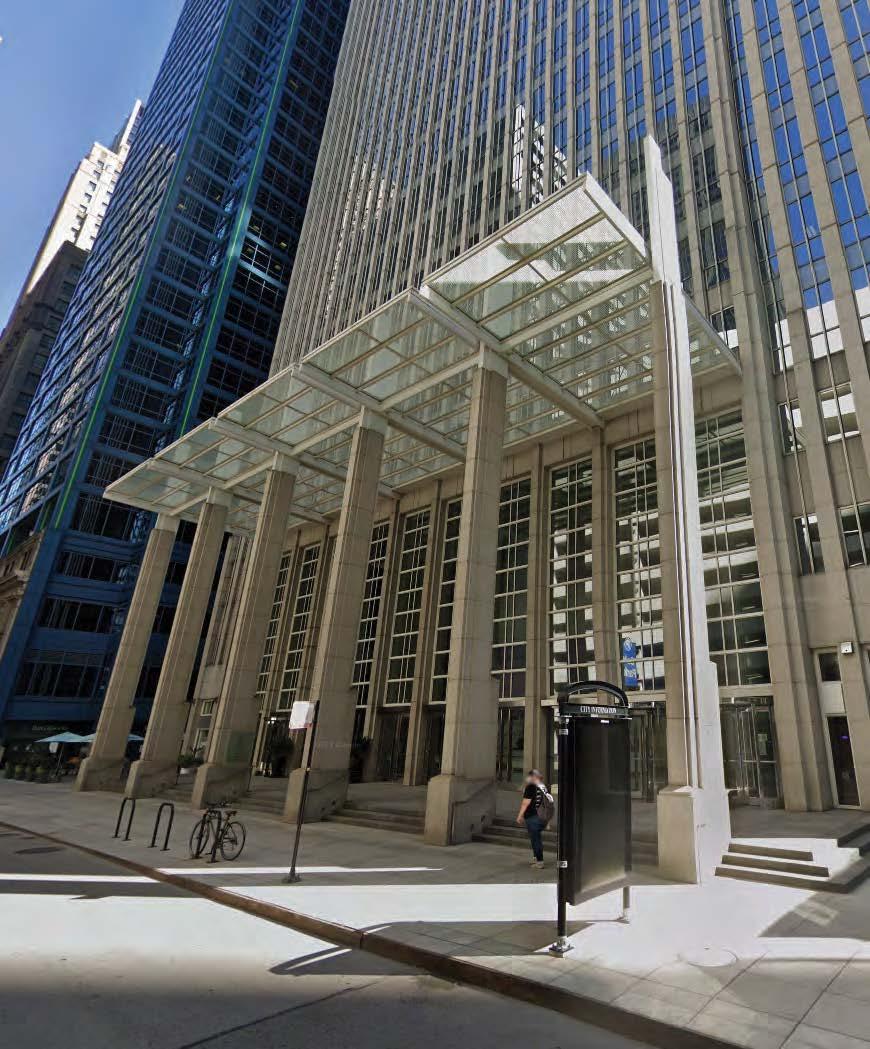
Also unclear is the outcome for the lender that holds a $240 million mortgage on the building, which was packaged with other loans and sold o to commercial mortgage-backed securities investors. Based on recent valuations of other Loop o ce properties, it’s likely the building is worth substantially less than the value of the debt.
e judge’s ruling was tied to a legal battle between HNA and a venture controlled by SL Green over the latter’s investment in a Manhattan o ce building at 245 Park Ave. SL Green last fall took control of that New York property, but Koeltl also last year con rmed an arbitrator’s decision that SL Green was still an HNA creditor owed $185 million by the Chinese company.
Koeltl’s order last month involving 181 W. Madison called out HNA for attempting to “frustrate and obstruct” SL Green’s e orts to collect on that judgment by, among other things, trying to transfer the Chicago property last fall to other China-based HNA a liates.
“SL Green intends to pursue any and all available measures to ob-
SQ.
28301 FERRY ROAD, WARRENVILLE, IL
tain control of (181 W. Madison) to satisfy the outstanding $185 million judgment,” said Mark Ressler, a partner in New York law rm Kasowitz Benson Torres, which represents SL Green.
Spokesmen for HNA and SitusAMC, a special servicer overseeing the loan on behalf of CMBS investors, did not respond to requests for comment.
LONE CHICAGO HOLDING
e 33-year-old Loop tower would be the only o ce property in Chicago owned by SL Green, a real estate investment trust best known for its Manhattan o ce buildings.
An HNA venture paid $355 million in 2017 for 181 W. Madison and put it up for sale just more than a year later, but the tower never traded. e venture instead re nanced the property in late 2019 with the $240 million CMBS loan.
e 937,000-square-foot building was 86% leased at the end of 2022, according to data on the CMBS loan reported by real estate information company CoStar Group. at is ahead of the 78% average
181 W. Madison St.for downtown o ce buildings. Risk management consultancy QRM is the largest tenant, followed by the Marmon Group and CIBC, according to CoStar.
e tower is just steps from a LaSalle Street corridor that is rife with vacant o ce space in
outdated buildings and could be revived with city-subsidized o ce-to-apartment conversion projects. City planning o cials are reviewing plans for ve such projects along and near LaSalle that would collectively create more than 1,600 residential units.
About six years after opening a showroom at a prominent Gold Coast intersection, Tesla wants out.
The electric-car maker has hired brokers at ARC Real Estate to sublease its 5,400-square-foot retail space at 901 N. Rush St., according to an ARC marketing brochure, signaling that it plans to close the showroom. It’s one of two Tesla showrooms in the city.
as hard as it is on North Michigan Avenue to the east, which continues to struggle.
“The Gold Coast market is exceptionally strong right now, bordering on frothy,” said John Vance, principal at Stone Real Estate, a Chicago retail brokerage.
The space is part of the 900 North Michigan Shops mall. Tesla occupies the space under a lease that expires in March 2027, with options to extend it for two more five-year terms.
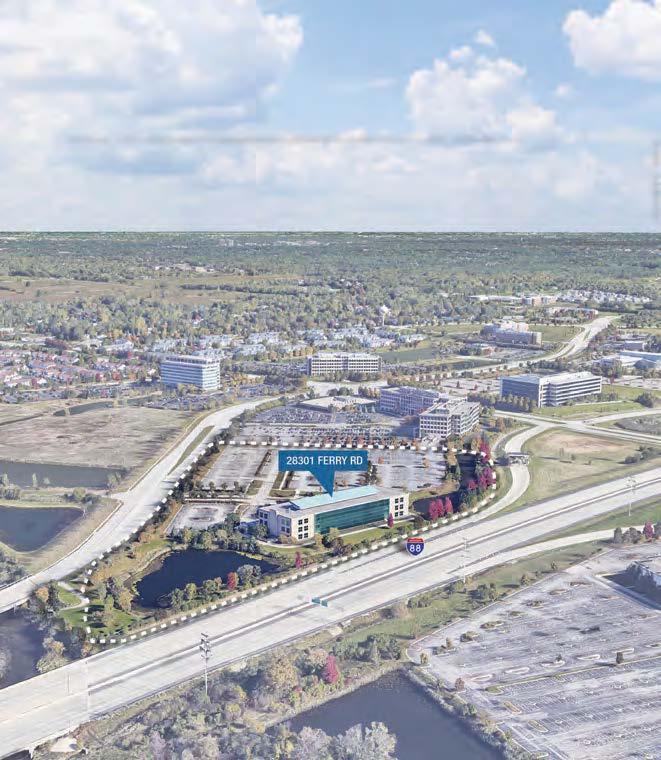
Built in 1999, with updating in 2022, and situated on approximately 19 acres with 950 parking spaces and excess land in the Cantera Business Park. This currently vacant property was formerly owned and occupied by oil giant BP subsidiary Amoco Research. Ideal potential uses include: school, training center, church, data center, corporate headquarters, etc.
Replacement Value in Excess of $20,000,000
Suggested Opening Bid $4,750,000
On-site Inspections 11am to 2pm on June 27th, July 12 and 17 and by Appointment.
(High-Profile Chicago Suburban Locale) Rick Levin & Associates, Inc. since 1991 312.440. 2000 | www.ricklevin.com
Tesla’s decision opens up a second storefront at the corner of Rush and Delaware streets, after Intermix, a multibrand women’s fashion retailer, closed its store across the street earlier this spring. But the Gold Coast shopping district has flourished since the pandemic, so finding tenants for the two spaces shouldn’t be
It’s unclear why Tesla is marketing its Rush Street showroom for sublease. The decision may be part of a broader shift in its marketing strategy. In 2021, the Austin, Texas-based manufacturer decided to close showrooms in shopping malls and focus on less-expensive locations.
Tesla did not respond to a request for comment, nor did brokers for ARC.
Tesla opened the Gold Coast showroom in November 2017.
If Tesla were to close the Gold Coast location, it would have only one showroom left in Chicago, at 1053 W. Grand Ave. in the River West neighborhood. The company also has stores in Highland Park, Schaumburg, Libertyville, Westmont, Naperville and Orland Park, according to its website.
Intermix, meanwhile, ran into financial trouble earlier this year after Regent, a Beverly Hills, Calif.-based private-equity firm, acquired the chain last fall. Intermix closed at least 17 stores earlier this spring, including the one in the Gold Coast, at 900 N. Rush St.
HINZ from Page 2
If downtown commuters haven’t returned, the CTA will be in desperate straits, barring a fat new state subsidy. Either way, the agency’s business model seems broken. But there’s no sign its leadership is adapting to that reality.
President Dorval Carter is a whiz at getting federal capital money. But when it comes to reorienting the CTA for an era when people
work from home and nd Uber an easy way to get around, he’s come up short. Perhaps if he started riding the system more often — Block Club Chicago recently reported that Carter used his work pass to ride vehicles all of 24 times in two years — he might understand his customers’ angst.
Again, I’m not saying they’re not trying. But it’s not enough. Right now, Chicago is throwing away one of its prime selling points to
live here, play here or set up a business here. And if you don’t believe me, ask yourself why the Illinois Legislature just passed a bill threatening to cut o CTA funding if lawmakers don’t start to get regular reports on safety, vehicle operations and the like.
If the new mayor wants to make a lot of people happy on all sides of town, he’ll assemble a repair crew soon to take on this challenge. Right now, it just ain’t working.
ing ahead amid a strong suburban apartment market: e median net suburban rent rose 5.9% in the rst quarter from a year earlier, according to Integra Realty Resources, an appraisal and consulting rm.
 BY ALBY GALLUN
BY ALBY GALLUN
Two local developers are moving forward with plans for a nearly 300-unit multifamily housing project near the West eld Old Orchard shopping mall in Skokie, an area that could emerge as an apartment hot spot over the next few years.
A joint venture between Chicagobased Tucker Development and Mount Prospect-based Wingspan Development Group has acquired a site on Old Orchard Road just west of the Edens Expressway, where it plans 249 apartments and 49 rental townhomes.
e village of Skokie approved zoning for the luxury development in December. Tucker and Wingspan are seeking construction nancing for the project and aim to break ground by the end of the year, said Aaron Tucker, Tucker’s president and chief investment o cer.
ey may have some competition. e owner of West eld Old Orchard, on Old Orchard Road just east of the Edens, plans to tear down the vacant Bloomingdale’s department store at the mall and build about 360 apartments in its place.
And the owner of the Old Orchard Towers o ce complex just east of the Tucker-Wingspan site recently put the property up for sale, marketing it as a teardown candidate to apartment developers. Under one potential plan for the site, a developer could build nearly 600 units there, according to a marketing brochure for the property.
Tucker said he and his father, Tucker Development CEO Richard Tucker, had been eyeing their site at 5400 Old Orchard Road — best known as the former home of the Portland Cement Association — for a long time. It’s across from Harms Woods, down the road from the Old Orchard mall and less than a minute by car to the Edens, leading to downtown and the northern suburbs.
“It’s super unique to have all of that and be this close to the city of Chicago,” Tucker said.
Tucker and Wingspan are push-
But they face headwinds in the real estate nancing market: Rising interest rates have pushed up borrowing costs, and lenders have become more conservative, making it harder for developers to nance new projects.
Tucker and Wingspan are in “negotiations with several lenders,” Tucker said. He declined to say how much the Skokie project will cost, or how much the developers paid for the property.
ey’ll demolish a 130,000square-foot o ce campus on the site occupied by Construction Technology Laboratories, or CTLGroup, a former subsidiary of the Portland Cement Association that was acquired in 2019. e PCA unit built the campus in 1948.
CTLGroup, a consulting rm that provides engineering, testing and other services to clients in the concrete and building materials industries, plans to move its headquarters, and all 60 people who work there, from the Skokie location to two buildings in the Kensington Business Center in Mount Prospect, according to a CTLGroup spokeswoman.
Tucker and Wingspan plan to build a four-story, multi-wing apartment building fronting Old Orchard Road that will include studio, one-, two- and three-bedroom units. ey would build the three-story townhomes, with three- and four-bedroom units, in the back. ey’ve set aside 13 units as a ordable to renters who earn 100% of the area median income — $110,300 for a household of four.
Arlington Heights-based HKM Architects & Planners designed the Skokie project.

Tucker is trying to get the Skokie project going as it wraps up another big project in Lincolnwood. On May 27, the rst residents moved into District 1860, a mixed-use development with 299 apartments that Tucker is building on the former site of the Purple Hotel.
“We’re making great progress” on District 1860, Tucker said, declining to say how many apartments the developer has leased there so far.

The venture behind the Old Orchard Road project still needs to secure nancing — a tough task these days
On the mayoral campaign trail, Brandon Johnson was the only candidate who refused to pledge to resta the Chicago Police Department’s o cer corps, arguing the city needed to get smarter about crime, not tougher.
During the run-up to Election Day, that message didn’t entirely match what many in the business community wanted to hear. And yet, now that Candidate Johnson is Mayor Johnson, a group often billed as the top echelon of the city’s corporate elite is singing the new mayor’s tune.
As Crain’s Greg Hinz reported June 1, the Civic Committee of the Commercial Club of Chicago is pledging to raise tens of millions of dollars and hire thousands of at-risk individuals in a bid to curb the epidemic of street crime that has a icted the city for years.

In a statement and a series of interviews, members of the group’s Public Safety Task Force, headed by industrialist Jim Crown, said the goal of their plan is nothing short of making this the safest big city in America, cutting the number of homicides by 75% over the next decade and slashing shootings by even more. To get there, the committee proposes a major expansion of violence-intervention programs and investments in long-neglected neighborhoods — both key priorities of Johnson and his allies.

But, as Hinz notes, the task force’s vepoint program is notably silent on the contentious question of whether Chicago has enough police o cers walking the
beat in the city’s neighborhoods. And the recommendations virtually ignore other key players in the city’s crime picture, notably the Cook County state’s attorney and Cook County Circuit Court, both of which frequently were blamed by former Mayor Lori Lightfoot for letting too many criminals go free.
“Our ve commitments re ect what business can bring to the table — a table that needs to be bolstered with leaders
from across all sectors and work together and hold each other accountable,” Civic Committee President Derek Douglas said in an interview with Crain’s. He added, “We can and must support e ective, constitutional policing, while doing what we can to support those that put their lives on the line.”
at’s fair enough, but business can and surely must also advocate for renewed sta ng of the city’s depleted police o -
YOUR VIEW
cer ranks. e CPD currently has about 1,600 fewer o cers than it did before the pandemic. And while Johnson and others would be quick to argue that adding ocers does not necessarily reduce crime, the past three years suggest in a compelling and at times horrifying way that having fewer o cers doesn’t necessarily reduce crime, either.
Making people feel safe on the streets where they and their families live and work is the most important priority facing the Johnson administration right now — and the local business community has a lot riding on helping the mayor to get the crime- ghting formula right. Every stakeholder agrees more communitylevel investment is necessary to get at the root causes of poverty and the violence it engenders — and the Civic Committee should be commended for putting real money on the line to fund e ective neighborhood programs and to hire people who want to work toward a better life for themselves and their families. Furthermore, every Chicagoan should be an advocate for fair and equitable policing in a city that for too long has turned a blind eye to abuses and injustices.
But if the Civic Committee is going to issue a business-minded prescription on issues of law enforcement and reform — and if it is to truly re ect the sentiments not only of downtown businesspeople but their counterparts in neighborhoods hit hardest by violence — then it should also call for a fully sta ed police force.
As a personal-injury attorney in Illinois, I have witnessed rsthand the devastating consequences of rideshare accidents and assaults. at is why it is crucial for ridehail companies like Uber and Lyft to prioritize safety and be held accountable for any failures in safety measures.
Unfortunately, the current safety standards set for ride-hail companies are insu cient and do not provide adequate protection for passengers (or drivers, for that matter). In light of this, the Illinois legislature is considering a bill that would classify ride-hail companies as “common carriers” and hold them to a higher standard of safety, just like taxis and other public transportation companies.
Under Illinois law, a “common carrier” owes its passengers the “duty to use the highest degree of care consistent with the type of vehicle used in the practical operation of its business.” at seems like a
sensible rule for companies that make millions of dollars on our roadways, right? Under the current system, however, Uber and Lyft are exempt from this standard and are instead judged like every other motorist on the roadway. at allows their drivers to be less vetted, less experienced and less safe.
By classifying these companies as “common carriers,” they would be legally required to ensure the safety of their passengers through measures such as comprehensive background checks, regular vehicle maintenance, and safety training for drivers. is change would provide greater protection for passengers and ensure that ride-hail companies take their responsibility to provide safe transportation seriously.
How many news stories have we seen in the past decade about injuries, assaults, rapes and other crimes in rideshare cars? One reason for these failures is that ride-
share companies currently have little incentive to require a safe experience.
Consider the example of Doe v. Lyft, a case in which a woman in Chicago was allegedly sexually assaulted by her Lyft driver. In that matter, Doe fell asleep in the Lyft car, and her driver allegedly drove to a secluded alley, where he brandished a knife, ziptied Doe’s hands and repeatedly assaulted her. e woman sued the driver, Lyft and the company used by Lyft for background checks. Lyft argued that it was not liable for any of the victim’s damages, since its drivers were de ned by Illinois law to not be common carriers. Presumably to Lyft’s satisfaction, the Illinois Supreme Court dismissed the case in January 2022.

It goes to show that Uber and Lyft’s primary interest is to be “cheap” rather than “safe.”
If you are an Uber or Lyft customer, you have probably received an email recently urging you to press your lawmakers to oppose House Bill 2231. e rideshare companies say the legislation is a “disguised safety bill” and will cause dramatically increased fares.
ese misleading tactics are an attempt to trick passengers into lobbying against a bill that would protect them. e fact is that House Bill 2231 is not a disguised safety bill but rather a legitimate e ort to ensure the safety of rides-hail passengers. at Uber and Lyft are trying to deceive their passengers into believing that this legislation is solely about increasing fares is deeply concerning. It is clear that their primary concern is their bottom line, not the safety of their customers. is type of behavior is unacceptable and must be called out.
It is worth noting that other cities and states have implemented increased safety standards, and the rideshare companies seem to be operating without issue. Furthermore, safety improvements like driver training, enhanced background checks, and in-app emergency features can be e ective and cheaply employed.
Regardless, the safety of passengers must come before the pro ts of ride-hail companies, and we must continue to push for legislation like House Bill 2231 that prioritizes passenger safety.
Crain’s contributor Edward Keegan is a Chicago architect and a contributing editor to Architect Magazine.

The site plan for Bally’s $1.7 billion Chicago casino was approved last month by the Chicago Department of Planning and Development.
e mixed-use development replaces the Chicago Tribune’s Freedom Center on a 30-acre site between the Chicago River and Halsted Street, south of Chicago Avenue. e newly tweaked plans include a casino, food hall and restaurants, a theater and event space, a museum and exhibition area, and VIP areas, as well as a 500key hotel. A full third of the site will
comprise open space, including community access to the Chicago River.
Bally’s claims in a press release that “the riverfront location is being hailed as a springboard for the next generation of entertainment, as the rst ground-up mixed-use gaming complex and resort located in the center of a major metropolitan city.” Clearly, the stakes are high.
So, what should a contemporary city casino look like?
Well, Certainly something better than what’s currently envisioned. is is the second design iteration
that we’ve seen for this project, and it hardly lives up to the high standard of Chicago architecture. e heart of the complex, and the rst phase of the project, is a genuinely undistinguished lozenge-shaped glass-clad hotel tower at Chicago Avenue, with an approximately 1,000-foot-long tail structure that holds the casino and related functions stretching southward along the west bank of the North Branch.
It’s drab, it’s banal, and it looks like it’s intended to last for a decade at best.
e previous scheme recalled an
oversized shopping mall with lots of glass presumably signaling “openness.” Also on display: an excessive array of awkward openings likely intended to denote “vitality.” e new proposal sports considerably less glass and adopts the instantly recognizable forms of stylized icebergs clad in corrugated metal.
e designers, a big team of talented local rms headed by Gensler, will be well-advised to look to some of the immediately surrounding buildings that have seen the passing of time better than the Tribune’s forlorn structure.
Assistant managing editor/digital Ann R. Weiler
Assistant managing editor/news features
Cassandra West
Deputy digital editor Todd J. Behme
Deputy digital editor/audience
and social media Robert Garcia
Digital design editor Jason McGregor
Associate creative director Karen Freese Zane
Art director Joanna Metzger
Digital designer Christine Balch
Copy chief Scott Williams
Copy editor Tanya Meyer
Contributing editor Jan Parr
Political columnist Greg Hinz
Senior reporters
Steve Daniels, Alby Gallun, Ally Marotti, John Pletz, Dennis Rodkin
Reporters
Katherine Davis, Brandon Dupré, Danny Ecker, Jack Grieve, Corli Jay, Justin Laurence, Steven R. Strahler
Contributing photographer John R. Boehm
Researcher Sophie H. Rodgers
Senior vice president of sales Susan Jacobs
Vice president, product Kevin Skaggs
Sales director Sarah Chow
Events manager/account executive Christine Rozmanich
Production manager David Adair
Events specialist Kaari Kafer
Custom content coordinators
Ashley Maahs, Allison Russotto
Account executives
Linda Gamber, Claudia Hippel, Menia Pappas, Bridget Sevcik, Laura Warren
Sales administration manager Brittany Brown
People on the Move manager Debora Stein
Keith E. Crain Chairman
Mary Kay Crain Vice chairman
KC Crain President/CEO
Chris Crain Senior executive vice president Robert Recchia Chief nancial o cer
Veebha Mehta Chief marketing o cer
G.D. Crain Jr. Founder (1885-1973)
Mrs. G.D. Crain Jr. Chairman (1911-1996)
For subscription information and delivery concerns please email customerservice@ chicagobusiness.com or call 877-812-1590
(in the U.S. and Canada) or 313-446-0450 (all other locations).
ORBA, Chicago
ORBA, one of Chicago’s largest public accounting rms, welcomes Justyne Powell as a member of ORBA’s Cloud CFO Services. She will be maintaining accounts receivable and accounts payable, handling monthly closings and preparation for monthly nancial statements and managing reconciliations of balance sheet accounts, account/bank reconciliations, payroll administration and customer service and client care.

Powell Chunduri
Clare Chunduri joins as ORBA’s Talent Acquisition Specialist. She will be developing sourcing strategies, managing full-cycle recruiting initiatives, leading new hire calls and creating a positive experience for both candidates and the ORBA hiring team.
Governor J.B. Pritzker appointed Michael Best Law Firm Partner Jorge Leon to serve as a member of Northeastern Illinois University’s Board of Trustees. Leon co-leads the rm’s Employee Bene ts group. Known to be a go-to advisor for helping higher education institutions and companies solve critical governance, compensation, duciary and bene ts issues, Leon will be able to translate his professional skillset to advance Northeastern Illinois University’s mission, offerings & strategic vision.
American Health Information Management Association (AHIMA), Chicago

Levenfeld Pearlstein is pleased to welcome Chris Andres-Pochon as a partner in the corporate group. Chris’ practice focuses on mergers, acquisitions, divestitures, joint ventures and corporate governance matters. He has extensive experience advising private equity and strategic clients on both buyside and sell-side transactions in the nancial services and ntech industries. He also counsels clients on commercial and residential real estate joint venture projects.






Susan (Suzy) Cowen has joined Kittleman & Associates, a national executive search rm specializing in recruiting CEOs for nonpro ts throughout the country. In her role as Senior Principal at Kittleman, Cowen will bring her extensive background that includes behavioral health and social services to leading all aspects of executive searches, including strategy, facilitation, client engagement, and recruiting candidates.
BMO, Chicago
Jen Guidi has been appointed as the new Head of the U.S. Diversi ed Industries Group at BMO. She will be overseeing BMO’s Diversi ed Industries operations in the Midwest, Central and East Coast regions of the U.S. In her 20+ years at BMO, Jen has held a variety of business leadership roles and overseen numerous strategic projects, and will now lead the growth of U.S. Diversi ed Industries team, which has signi cantly expanded the bank’s market access to high-growth regions across the U.S.




Amy Mosser, MBA, has been appointed interim chief executive of cer at AHIMA. For the past four years, she has been a critical member of the AHIMA executive team, driving strategic margin growth and stabilization through the COVID-19 pandemic. She most recently served as chief growth of cer at AHIMA. Before joining AHIMA, she served in highgrowth and transformative healthcare companies in the US and Europe.

American Health Information Management Association (AHIMA), Chicago
Stephanie Kowalski joins AHIMA as chief marketing of cer. She has 30 years of B2B and B2C marketing experience, mostly in the healthcare sector, and a proven record of accomplishing corporate objectives and increasing revenue through creative marketing strategies and programs. Her marketing experience includes brand strategy and positioning, corporate and internal communications, public and media relations, lead generation, and business development for startups and Fortune 500 companies.
USO, Midwest Region USO is proud to announce Andre Bonakdar, Senior Vice-President and Credit Executive at BMO Financial Group, as the newest member on the Midwest Advisory Board. Andre went from the U.S. Navy to BMO in 2006 and promoted to an Executive in 2019. He graduated from the U.S. Naval Academy and obtained an MBA from the University of Notre Dame. USO is a non-pro t organization whose mission is to strengthen service members by keeping them connected throughout their service to the nation.

Kittleman & Associates, Boston
Byline Bank, Chicago


Byline Bank welcomes Adnan Assad as Senior Vice President, Commercial Banking Division Head. Assad’s commercial banking career spans 25+ years working for multiple regional nancial institutions. As part of Byline’s commercial banking team, Assad will report to Brogan Ptacin and work with small to midsize closely held businesses throughout the Chicagoland market, including manufacturers, distributers, non-for-pro t and contractors, and continue to focus on growing Byline’s franchise lending practice.


American Health Information Management Association (AHIMA), Chicago
Lauren Riplinger, JD has been promoted to chief public policy and impact of cer at AHIMA. In this role, she provides strategic and operational oversight over AHIMA advocacy and programmatic activities to demonstrate mission impact. She previously served as vice president of policy & government affairs at AHIMA, overseeing its policy and advocacy agenda and priorities before Congress and various federal agencies. Lauren has two decades of healthcare policy experience and previously worked on Capitol Hill.
Lendlease, Chicago

Nick Iselin was promoted to Executive General Manager, Development, Central Region. Much of Iselin’s nearly 30-year career has been with Lendlease in Boston, where he led the development of FORUM, a 350,000-square-foot life sciences facility, and Clippership Wharf, a 478-unit mixed-use development.
Kinjal Patel was promoted to Executive General Manager, Construction, Central Region. An 18year veteran of Lendlease, Patel has led many large-scale projects from preconstruction through completion. Iselin and Patel will contribute to Lendlease’s integrated platform, which encompasses expertise in development, construction and investment management, as the rm grows its own property portfolio while continuing third-party construction work.
Kittleman & Associates, a national executive search rm specializing in recruiting CEOs for nonpro ts throughout the country welcomes Heather Merriam, an expert in leadership, management, consulting and recruiting for nonpro ts ranging from small grassroots to large organizations. In her role as Principal, Merriam will lead search assignments and engage in business development. Kittleman & Associates, a national executive search rm specializing in recruiting CEOs for nonpro ts throughout the country names Jeff Katz, a nationally recognized child welfare expert and nonpro t leader, as Principal to its Boston of ce. In this role, Katz will work with client organizations to recruit for leadership positions and engage in business development.


Merriam Katz

With open floor plans and movable furniture, employees working in offices today enjoy more flexibility. They can work from an upholstered booth, a tufted leather sofa or a sunlit rooftop. They can manage and make executive decisions while seated at a bar, cappuccino or otherwise. The lucky ones also can indulge in food from a gourmet kitchen or relax in a steam shower in the spa. Here, in our annual Coolest Offices Contest, we showcase the best-designed places Chicagoans work. The winners were chosen by design writer Zlata Kozul Naumovski and Jan Parr, a Crain’s editor and former shelter magazine editor. By Zlata




Space: 70,000 square feet over two floors in the Civic Opera House building.
Who did it: In-house design team of Elide Rathborne, Thomas Gibbons, Katharina Hoerath and Ryan Greenwood.
Cool because: The design is sophisticated and relaxed with dusty tones of blush, griege and steel blue. Custom booths are upholstered in plush fabric, while a gorgeous circular sofa invites employees and guests to unwind. Combined with bleached wood floors, natural wood tones and marble surfaces, the space has more in common with a chic hotel than a typical office.
Coolest feature: Sun-drenched office suites with views of the Chicago River. Why employees like it: The space is pet-friendly and includes luxe amenities, such as shower rooms with towel service, multiple gourmet kitchens with state-of-theart appliances and a furnished outdoor space. Plus, everyone looks good in the stunning mirrored stairwell that connects both floors.
Kozul NaumovskiSpace: 31,000 square feet in a historic factory building in Fulton Market.


Who did it: In-house design team of Elide Rathborne, Thomas Gibbons, Katharina Hoerath and Ryan Greenwood.
Cool because: The space feels like an intimate nautical club reminiscent of the waterways and vessels that meander through Chicago. Materials are cool and sexy, with leather and velvet dominant. Lighting, finished in aged brass, is rugged yet refined. Deep, cool tones permeate the office. Modern pieces mix effortlessly with vintage ones.
Coolest feature: Hands down, the architecture: gorgeous original timber beams, exposed brick, vaulted wood plank ceilings and oversize windows that wrap the perimeter. We couldn’t pick just one.

Why employees like it: The environment is simultaneously luxurious and relaxed. “Our team made conscious efforts to evoke peace and savor the beautiful details of the past, paying homage to this amazing city of Chicago,” according to Creative Director Thomas Gibbons.

Space: 4th and 5th floor amenity spaces of corporate headquarters in Willis Tower.

Who did it: Gensler
Cool because: The space incorporates artifacts from the company’s history into the design, such as lettering from a decommissioned hangar, an engine inlet and 747 airplane windows.
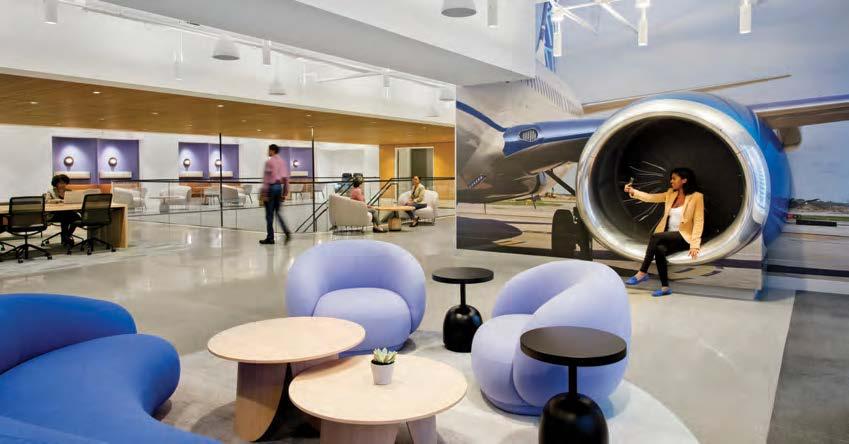
Coolest feature: A library featuring vintage travel posters and soft lighting that invites connections and conversations and two expansive green spaces outside, complete with terrace furniture and rooftop views.
Why employees like it: Tons of natural light, and the whole vibe is more art-museum lobby than corporate cafe.

Space: Top two penthouse floors of the Civic Opera House. Who did it: Eastlake Studio.
Cool because: The space boasts breathtaking views from every direction with massive circular windows that create an open and airy feeling.
Coolest feature: The 15th-floor roof deck —nothing beats access to fresh air and a stunning view, but the large open loft that doubles as a giant meeting and event space is a close second.

Why employees like it: The office was built with collaboration in mind, and it feels like a private coworking space for employees. Plus, conference rooms pay homage to influential women such as Serena Williams, Maya Angelou, Frida Kahlo, Rosa Parks and Ruth Bader Ginsburg, a nice touch for a company committed to helping women remain active in the workforce.



Space: Two floors of an office building on Upper Wacker Drive.
Who did it: Perkins & Will.
Cool because: The design offers a more casual, residential atmosphere that inspires people to return to the office. Plans are organized around zones called The Clouds, noted for their curved ceilings. Outfitted with full-height glass or playful ceiling light fixtures, these spaces provide an abundance of natural light and dynamic views to outside.
Jewel-toned colors, light wood, layered textures and live plants create a warm, inviting space that feels more like home than an office.
Coolest feature: Distinct hospitality spaces such as a baristastaffed café serving specialty beverages; a grab-and-go market offering fresh, locally sourced food, and an indoor play terrace that can accommodate live music as easily as table tennis.
Why employees like it: The space offers more than 40 types of work settings — from open booths to team rooms with privacy drapery — that support differing behaviors and postures throughout the day. Workspaces and day lockers can be reserved via a phone app. Additionally, employees have access to privacy rooms with spa-like finishes and single-use, all-gender restrooms.
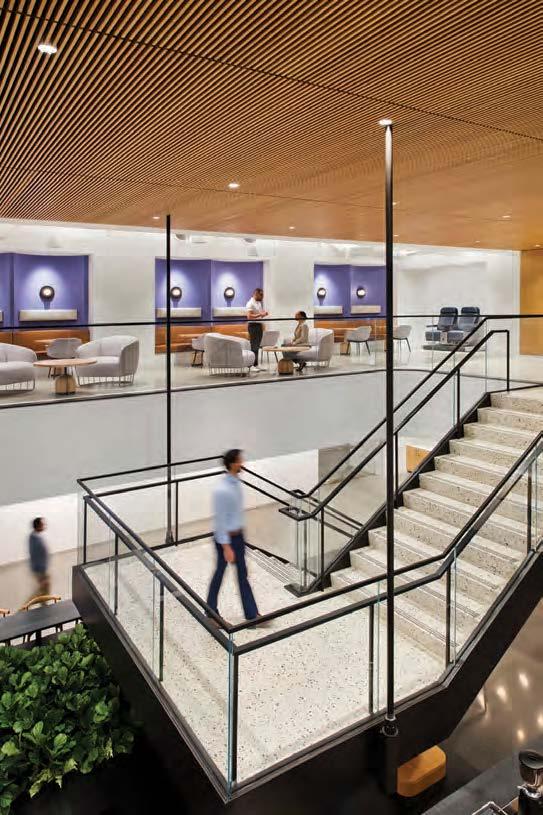
Space: An historic building in River North.
Who did it: NORR Chicago Interior Design Studio.

Cool because: The urban space is diffused with colors of blue skies and lakes (check out the painted ceiling with exposed ductwork!), tactile art and funky murals from local artists. An open floor plan promotes collaboration and movement. Furniture is movable.

Coolest feature: The curtain of bronze metal beads in the center of the studio. It creates a concentration pod that allows any employee to plug in and do design work.
Why employees like it: With a flexible and dynamic floor plan, employees are able to pick where they work and how they want to work. “The hybrid space adapts to anyone’s needs in these ever-changing times as we turn the page on COVID-19,” said Nick Hernandez, NORR Chicago Interiors studio manager.

Space: Top four floors of the newly constructed 345 North Morgan in Fulton Market.
Who did it: Partners by Design.
Cool because: The design is cohesive, welcoming and inspiring and reflects the rich industrial heritage of the Fulton Market neighborhood. Soaring 15-foot windows are defined by arches in the signature townhall space, where employees can mingle at a full bar or in front of the fireplace. Installations such as an interactive mural and a massive mechanical flip board help transform common areas.
Coolest feature: All four floors have access to an outdoor deck. The rooftop, shared by other building tenants, has an exclusive area for Havi employees only.
Why employees like it: All spaces were designed to bring employees together. Furniture is comfortable and beautiful, and technology is current to ensure that even remote employees feel included. And if specialty rooms such as the innovation and focus-group labs, which offer additional collaboration opportunities, aren’t inspiring enough, nothing says teamwork like grabbing a cocktail with your work besties at an easy-to-walk-to joint in the coolest neighborhood in town.

Space: 18th floor in an iconic River North skyscraper
Who did it: Eastlake Studio
Cool because: Perimeter offices with floor-to-ceiling windows encircle the 5,560-square-foot space and provide unobstructed river and skyline views.


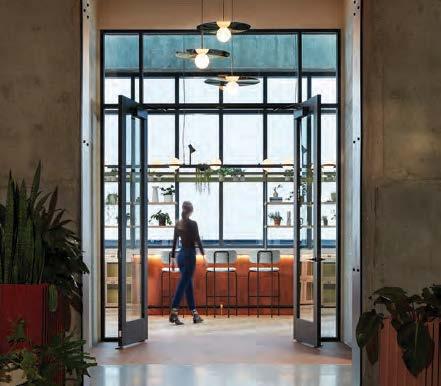


Coolest feature: A hidden door disguised as kitchen cabinetry that leads to an immersive showroom in which visitors can learn more about buildings available for lease.
Why employees like it: The space supports employees’ ability to entertain, socialize, collaborate, focus and even rest. It’s not just a space to hammer out work.

Space: A 230,000-square-foot new-construction office building in Fulton Market.

Who did it: Sterling Bay
Cool because: The property, directly adjacent to Google’s Midwest headquarters and the Emily Hotel, exudes character. Drawing on the neighborhood’s industrial past and its enduring spirit of innovation, the LEED-designed building possesses soaring ceilings, arched windows and welded metal accents. Natural light permeates every corner. Floor plates are customizable for maximum flexibility and collaboration.
Coolest feature: Near floor-to-ceiling windows clad all sides of every level, providing exceptional views of Chicago’s famous skyline in all directions.


Why employees like it: So many amenities to choose from: private outdoor terraces; a 5,000-square-foot roof deck with sweeping views; a conservatory bar and lounge with a double-sided fireplace; a full-service fitness and wellness center; a co-working library, and several high-tech conference spaces. And if employees choose to leave the comfy confines of the building, the city’s coolest bars, restaurants and shops are literally steps away.

Space: A hybrid design studio/ residential building in Logan Square.
Who did it: Mike Shively, En Masse founding partner.
Cool because: The architecture of the four-story building is simple and modern. Bold, concrete panels on the facade of the steel and glass structure control light. The top two floors serve as the private residence for the founder while the bottom two function for the business.
There’s a strong connection to the outdoors with floor-to-ceiling windows and sliding glass doors. For conference meetings, 12-foot steel doors with ribbed glass slide closed to provide privacy on the ground level. A nearby cappuccino bar fuels the creativity.

Coolest feature: The roof deck, where staff members can meet and work under a sun shade.

Why employees like it: With the studio space on the second floor, elevated from street level, the team of 11 employees enjoys a sense of privacy from passersby in the residential neighborhood and the stream of the natural light pouring in.




These companies get kudos for cool use of design elements or a special amenity.
At Accenture, a broadcast studio with state-of-the-art technology allows employees to create end-toend video solutions for global clients, including production, content creation and multimedia editing with broadcast studio capabilities.

We like the halo-like light fixtures and planted flowers in the open office of Brennan Investment Group
Cresa’s headquarters conjures a dark and moody vibe against the nighttime sky. It can easily be mistaken for a lounge in the most stylish hotel in town.With a brick wall, wood-paneled reception area and a poured concrete floor accented with a cowhide rug, the vibe at Energy CX is nothing but laid-back. A
wood runner on which employees can engage in work or just sit down for inspiring convo draws attention to the grand staircase at SMS AssistRYAN MCDONALD KENDALL MCCAUGHERTY ACCENTURE PRODUCTIONS MILES RICE TOM HARRIS CASEY FINN
Challenging circumstances often present opportunities for signi cant change. In the wake of the pandemic and its seismic impact on work and lifestyle trends, Chicago’s central business district is struggling with historically high of ce and retail vacancies. The situation gives developers and landlords incentive to reimagine older buildings with modern workers and residents in mind.
As real estate owners strive to realize the potential of their assets by (re)developing new and functional spaces, many questions arise about the unique challenges that lie ahead in this next stage of Chicago’s evolution. Three experts in repositioning buildings share their insights with Crain’s.
With the high vacancy in the Loop of ce market, adaptive reuse of old buildings or spaces is necessary. What are the biggest challenges in historic property renovation?
Patrick Kearney: e Loop was originally envisioned and still serves as the center of commerce, culture, and government within the City of Chicago. However, the Loop has struggled to retain o ce tenancy in an era that now requires a vibrant 24-7, mixed-use urban setting. e biggest challenges surrounding large-scale o ce to residential conversion in the Loop are the signi cant cost of conversion relative to achievable rents and lack of existing 24-7 vibrancy.
It’s a chicken and egg dilemma in that exciting retail/entertainment o erings will drive residential demand while a critical mass of residential drives the emergence of new retail concepts.
e City of Chicago realizes this dilemma and has responded by creating incentives to encourage both residential conversion as well as the creation of new retail/entertainment concepts. To create a truly vibrant Loop, it will require joint commitment from the City as well as building owners and businesses.

Chris Pemberton: First of all, I have to take a moment to mention that the leadership exempli ed by the LaSalle Street Reimagined IFP is crucial to making this type of neighborhood revitalization feasible, given the very real nancial barriers. But from a purely architectural perspective, one of the greatest design challenges for adaptive reuse of the kind that we’re working on in the LaSalle Street corridor is geometry. O en, the space con guration of these older o ce buildings doesn’t lend itself easily to conversion to residential. e oor plates can be so deep that it takes creative thinking to recon gure that kind of area into desirable living spaces: bringing natural light in, for example –and in Chicago in particular, meeting requirements for operable windows in all bedrooms and living rooms. An example of this kind of creative design is our work on Tribune Tower, which had a similarly large footprint to the LaSalle Street o ce towers. ere, to bring in natural light and fresh air, we carved out a courtyard that also provides residents with a beautiful and unique amenity space. At the end of the day, it’s important to understand that o ce buildings are designed for a completely di erent kind of activity than residential buildings. It’s a huge
ANDY HALIK is Vice President at Chicago-based Skender, a full-service construction rm with strong expertise in building repositioning. Skender frequently partners with building owners and their property management teams to plan and safely execute major asset repositioning projects. The rm’s recent projects include the Merchandise Mart, 225 W Wacker, 1100 W Fulton and 3500 Lacey in Downers Grove. Andy has 20+ years of experience in the construction industry and leads Skender’s award-winning Interiors team. He works closely with project teams to maximize value for clients and deliver the premier construction experience.


challenge to convert them, but it’s rewarding to give them a second life.

Andy Halik: Preservation and restoration can be challenging when it comes to adaptive reuse in the Loop. ese older buildings have features that don’t always t into modern compliance/zoning regulations or tenant comfort expectations. Historic properties are typically not designed to accommodate modern accessibility standards, and their plumbing, electrical, HVAC and other infrastructure o en need costly and specialized upgrades. A lot of careful planning is required to hit the right balance between incorporating modern materials and the technology tenants expect and maintaining a building’s character. While this can be expensive, especially given the likelihood of running into structural obstacles in historic buildings, when done correctly it’s extremely rewarding.
From a design perspective, how should we achieve balance between modern and historic when repositioning the Loop?
Pemberton: Some of the buildings in the Loop are already recognized as historic landmarks. ese stately old buildings bring character and visual
PATRICK KEARNEY is Managing Director at AmTrust RE, a vertically integrated owner, operator, and developer. Patrick is based in Chicago and oversees the rm’s Central US Region in addition to running development and acquisition projects nationally. Previously, he led the Central US Region for Tishman Speyer where he was responsible for a variety of successful largescale ground-up and redevelopment efforts across the US. Over his 20+ year career, Patrick has acquired, developed, and sold more than 35 million square feet and $10.0 billion of commercial property.
CHRIS PEMBERTON, AIA, is Principal and President of SCB and provides rm-wide leadership, strategic vision, and project strategy across all of the rm’s practice areas. He has grown SCB’s national presence by establishing thriving practices in Seattle and Boston and expanded the rm’s strength in core market sectors to include signi cant work in aviation and life sciences. Chris’s project approach embraces multi-disciplined collaboration and technical innovation, leading to high-performing, beautifully crafted design solutions. He specializes in commercial of ce, hospitality, residential, adaptive reuse, and mixed-use urban in ll projects.


interest to the streetscape, as they o en incorporate notable datum lines, upper-level setbacks, and variations of window designs and stringcourse elements that help create a sense of proportionality and human scale from the street. From a design perspective, it’s crucial that new construction responds to these elements of massing and form, to maintain a respectful and harmonious interaction between modern and historic, to enhance the urban fabric.
Halik: On the plus side, some of the older Loop o ce buildings have much bigger, grander lobbies than existing residential buildings—a real opportunity when considering conversion. However, beyond the lobbies, we tend to see smaller windows, less space for socializing and less natural lighting than new builds. For o ce buildings that are staying o ce buildings but need modernization, we are seeing the addition of more outdoor amenities and retail and restaurant tenants to create a residential/hospitality feel for corporate employees. For example, a recent Skender project at 225 W. Wacker Drive renovated the historic building’s lower lobby, fourth- oor amenity space and roof deck using modern design elements. e upgraded amenity space features
operable Skyfold partitions for exible conferencing options; biophilia and plantings; high-end audio/visual technology; and commissioned art incorporating elements from the Chicago River, which pays homage to the building’s riverway backdrop.

Kearney: A major draw of the Loop is its historic architecture, ornamental details and large communal spaces that lend themselves perfectly to creating a unique and authentic feeling neighborhood. Repositioning e orts such as e Robey in Wicker Park have proved instrumental in creating a centerpiece within an already established community.
We, along with our development partner (Riverside) believe the 135 S LaSalle (Field Building) repositioning project will serve as one of these centerpieces in an evolving Loop neighborhood. Preserving authenticity through the restoration of historic elements is a key factor of the project and will ensure its relevance for the next 100 years. Our goal is to layer in both functional and aspirational spaces that support the modern live-workplay environment. Grand existing spaces within 135 S LaSalle and other historical LaSalle Street buildings serve as ideal backdrops for creating successful destination-oriented retail
ultimately enticing o ce tenants to return to the area.
Creative new retail concepts, public art and outdoor dining options will help LaSalle Street reinvent itself. Expansion of public markets, art shows, and holiday events will generate more tra c beyond typical work hours. Vehicular tra c is important to retain on LaSalle Street in some form, but there are several strategic infrastructure improvements that can be implemented. e abundance of nearby hotels, which were severely impacted by the lack of business travel during the pandemic, will be advantageous in promoting more tourism to the Loop as new retail and entertainment options come online.
area of the City. Without a publicprivate partnership for the LaSalle Street Reimagined initiative, o ce demand as well as the physical state of these historic buildings will likely continue to deteriorate. at scenario would negatively impact both the Downtown economy and tax revenue to the City.
and entertainment o erings catering to tourists, residents and o ce workers.
Google made a high-pro le decision to purchase the James R. Thompson Center in Chicago’s Loop. What sort of challenges will Google and other nearby landlords face when bringing a modern, functional appeal to a unique property?
Halik: Google’s situation is di erent than other nearby landlords in that the company’s core business is technology, not real estate. As a tech company, Google’s real estate decisions are less speculative than other landlords’ because they set the policy for where and when their employees are working, and their motivations may justify a greater investment when considering improvements to the base building. Building owners who are looking to lease entire buildings in the central Loop to multiple tenants with di erent needs and objectives have to delicately consider ROI when making decisions on where and how much to invest.
Ideally, Google’s revitalization of the ompson Center will bring some much-needed activity back to that neighborhood in the same way their move to Fulton Market has transformed that area, but there’s a lot of work that they are going to have to do to bring it up to their standards for a global HQ. It’s a unique older building with ine cient single-pane glass, the HVAC system needs a complete overhaul, and the elevators provide part of the building’s character but are extremely outdated. e lobby and plaza, while in need of investment as well, provide a signi cant opportunity to engage the public and create energy for the surrounding neighborhood.
What building amenities or uses can bring the most life back to the LaSalle Street corridor, long known as the heart of banking and nancial markets?


Halik: Building owners should consider creating a mix of amenities and uses for their spaces that can serve the needs of a diverse group of people and businesses. e most attractive buildings on the market right now feature common workspaces and amenities that replace the need for each tenant to build their own large conference and training rooms, provide a place to work or take a break outdoors, and create an environment that feels more like a trendy neighborhood co ee bar than a traditional o ce. New retail and dining options, outdoor parks, public plazas, tness and yoga studios would all give workers a reason to choose coming to the o ce and remain downtown instead of staying home or leaving early. ere is so much history in the LaSalle Street corridor, it just needs to be enhanced by the amenities that employees and employers are looking for in today’s market—amenities that are available in Fulton Market and are starting to become available in buildings along Wacker Drive and the river. If buildings in the LaSalle corridor follow this blueprint for a new age, that area could have a similar growth trajectory to Fulton Market.
Kearney: A combination of both service and destination-oriented retail is essential to support the daily lives of residents, while also drawing people to LaSalle Street on nights and weekends. While a neighborhood grocery option is vital, o ering dynamic food, beverage, and entertainment options is paramount in attracting residents and
Pemberton: At SCB, we have a lot of experience designing successful mixed-use urban districts, from creating district masterplans to then delivering buildings in a district we master planned. rough our experience, we’ve learned that to truly revitalize a neighborhood, we have to think beyond individual building amenities to the broader question of public realm bene t. I would say the three most important elements to this are: 1) Incorporating a range of retail spaces that vary in size and volume, attuned to what people want in their neighborhood, to support an increase in new residents to the area and serve their needs; 2) providing outdoor spaces for residents alongside access to thoughtfully designed spaces that are open to the public; and 3) creating a district plan to incentivize initial retailers while the neighborhood is initially being populated. is last piece is out of our hands as architects. But on the rst two points, you have a great example of how so much of good architecture is invisible: we also need to design all the back-of-house servicing areas and parking to support retail and public spaces. ese elements are essential to the functionality of the district. ey need to work, yet be unobtrusive. And they are especially challenging to incorporate into historic structures.
Most properties along and near LaSalle and from Randolph to Van Buren streets are part of the National Register of Historic Places. Do you feel most of the opportunity is for conversion versus new development?
Kearney: e opportunity is mostly conversion for a variety of reasons. Unlike other parts of the Loop, the area was fully developed many years ago with few remaining underutilized sites available for ground-up construction. Additionally, many buildings in the area are historically protected and are not candidates for demolition. In some cases, developers will be able to take advantage of federal landmark designation which allows for tax credits in exchange for signi cant new investment into these historical buildings.
Beyond federal tax credits, e City of Chicago has rightfully recognized that additional tax incentives are necessary to attract needed private capital investment into revitalizing this vital
Pemberton: Instead of the opportunity being about a choice between conversion or new development, it’s really about programming large-scale buildings into mixed-use destinations, whether new construction or adaptive reuse. e big opportunity is to combine residential and commercial, with buildings that incorporate both o ce and retail, or residential, hotel, and entertainment. For example, some of our adaptive reuse work in the LaSalle
users, so that residents feel they have privacy and security, and workers don’t get bogged down by residents getting their mail when they’re just trying to go to work. Indicating a sense of place is important, and with large-scale buildings like the ones we’re working with on LaSalle Street, we have the opportunity to design unique entrances that support the end-users’ speci c needs and interactions with the building.
Halik: Given the gap between supply and demand for Class B and C o ce space, especially in this area, conversion is a necessity. While the conversion of older buildings can come with many challenges, there are also advantages to taking a historical property and reimagining it for today’s market. e city, and Chicagoans, are rooting for a revitalization of the neighborhood. City-sponsored initiatives, a multitude

Street corridor will combine residential apartments and o ce programs, as well as retail and public realm bene ts. is is in part because the buildings are so large, they can both accommodate and bene t from this approach, and in part because when residents have access to commercial spaces it creates more vibrancy. It enables people to stay in their own neighborhood to do things like go grocery shopping, get their dog groomed, or go to work. is mixed-use approach will contribute to the longterm viability of the neighborhood. At the same time, it can be important to design for discrete separation of
of tax incentives, and signi cant political support are available; the question is where is the tipping point. ere is such great history in the architecture of these buildings, it’s hard to imagine them sitting vacant for long.
How does the construction timeline differ in adaptive reuse of a historic property versus a standard buildout? Are the materials used more dif cult to procure? What do real estate landlords and developers need to know about adaptive reuse construction?
Halik: e biggest thing to consider in an adaptive reuse or historic redevelopment is the necessary coordination with and between the governing historic bodies such as Landmarks Illinois, State Historic Preservation O ces (SHPO) and the National Park Service. When you’re making changes to things like lobby nishes, windows, corridor width and height—even historic handrails—you will need to run through the tricky submittal and approval process. It’s important to prove that the project is maintaining historic intent. When undertaking a historic redevelopment, there are always surprises. Project timelines are usually longer, specialized materials are harder to get, and costs can quickly escalate without architects and contractors well-versed in historic restoration to assist in the planning stages of redevelopment.
Kearney: A good rule of thumb is 12-18 months for adaptive reuse versus 18-24 months to complete ground-up construction. Construction timelines for adaptive reuse vary based on several factors including number of residential units, mechanical, electrical and plumbing complexity, as well as condition of older building envelopes and systems.
Much of the signi cant cost of conversion is uniform across buildings, so a detailed assessment of achievable rents and usable area are key to determining a good candidate. Many buildings in the Loop that have deeper oors and challenging views are better served to remain as o ce use. Dark, non-view space may negatively impact half of the residential units on a oor, while a larger, open o ce con guration bene ts the non-view portion of the oor. e desirable conversion candidates will likely move forward initially, while other buildings will ultimately bene t as competitive o ce inventory is removed and the Downtown o ce market rebounds.
would expect many of the a ordable units to be rented to college students or people in their rst jobs or early in their careers, or those who are working in nearby hospitality businesses like hotels and restaurants, or even entertainment venues.
Chicago’s nancial district is largely composed of historic buildings with distinctive features (thick walls, imposing columns, small windows, etc.) compared to other areas of the city with loft, medical, and trophy assets. What are the unique challenges and opportunities Loop building owners will face when repositioning their assets?
accessing all areas of the building. Energy performance is a challenge for vintage buildings, as the envelope needs to be upgraded to meet modern energy codes. Mechanical systems can be costly to upgrade but can also provide the biggest return on investment from a sustainability perspective. A full-scale, rapid transition to electric from natural gas is the current trend, although questions remain about power grid capacity and operating costs. Another opportunity is the repurposing of materials to reduce the carbon footprint that occurs from material manufacturing, transport or demolition. On an interior buildout, many sustainable applications like high-e ciency lighting and low VOC materials can be used.
companies like Hazel Technologies are turning to Fulton Market as a place for innovation. Pedestrian and bike-friendly infrastructure will be critical. But no project can move forward without buy-in from the community and government agencies. erefore, building in diversity, equity and inclusion (DEI) and public safety components to a plan will greatly increase its chance of success.
Reimagined” program demands that at least 30% of new housing in that area be classed as affordable under city ordinance. How would you approach that requirement?
Kearney: We have agreed to provide 30% a ordable units on-site and believe mixed-income housing is an integral part of creating a vibrant Loop. It’s also important to distinguish that a ordable units will be rented to households earning less than 60% of area median income. A signi cant percentage of these renters are expected to be comprised of essential workers in the Loop and recent college graduates, who would otherwise not be able to a ord to live close to their jobs. A good way to think about a ordable units at this income level is to refer to them as “workforce housing”.
A ordable rental products will also bene t companies occupying space in the Loop that employ individuals across the income spectrum. e LaSalle Street Reimagined initiative is also expected to create signi cant new employment opportunities in the hospitality industry that will create additional demand for nearby residential o erings at an a ordable price point.


Pemberton: We embrace these kinds of requirements because we believe that diversity brings vibrancy to buildings and neighborhoods. Whenever we design inclusionary, a ordable housing mixed into market rate housing, we know that this mix actually resembles the typical blend of people one might nd in one of Chicago’s many wonderful neighborhoods. And the inclusionary units look no di erent than the market rate ones, so once people move in, nobody knows who is who. It is truly equitable and it contributes to a district’s vitality. In an area like the LaSalle Street corridor, we
Pemberton: e historic buildings in the Loop are mainly o ce towers, which are composed of unique elements in comparison to buildings in other parts of the city. Some challenges include the obvious, like bringing the buildings up to current code compliance and providing a reasonable amount of onsite parking, to more nuanced design elements like considering enclosure acoustics, energy performance, and retro tting operable windows. But on the other hand, these buildings o er opportunities to design a higher number of unique unit plans than new construction, and o en more spacious units than new construction, both of which appeal to residents. Our work on Tribune Tower is an example of this, where we maintained the historic character of the building and designed 55 unique oor plans out of 162 total units – we saw a great response to all those options.
Kearney: Rarely will entire buildings be completely empty of o ce tenants. Consequently, to be considered a viable candidate for conversion, a building must be capable of functioning as both an o ce and residential building simultaneously. is means creating separate amenities, lobbies, and elevator access (especially if pets are allowed), to the extent possible. Developers will also likely separate the multiple uses from an operational, tax, and legal perspective to allow for more advantageous nancing and sale exibility.
Despite the complexity of these conversions, there are many positives. Typically an o ce building is constructed with taller ceiling heights to accommodate larger HVAC duct work for higher density use. is additional volume provides a signi cant bene t as compared to shorter ceiling heights in new apartment buildings. In addition to the historic architectural attraction and unique large-scale interior spaces, Loop buildings will be desirable due to proximity to downtown jobs and public transportation options.
In an adaptive re-use of a historic property, how dif cult is the retro tting of sustainable and low carbon features and where are the biggest opportunities?
Halik: e biggest challenge is the invasiveness of the retro t. Depending on the degree of the retro t, it can require
Pemberton: As a matter of best practice, SCB always speci es low carbon materials that are not on any red lists, that are responsibly sourced and produced. So we don’t approach historic preservation or adaptive reuse any di erently in that sense. Moreover, the greenest building is the one that’s already built, and dense urban living is the most sustainable type of living. ese historic buildings tend to be wellconstructed and well-insulated, which is helpful from a sustainability point of view. In terms of challenges, adaptive reuse of historic buildings can be almost as costly as ground-up construction, so there are nancial barriers requiring a visionary developer and a creative design team to nd solutions that work. What have we learned about the success of the Fulton Market neighborhood, and how can those lessons transfer to development in other areas of the city?
Halik: e success of Fulton Market lies in its around-the-clock vibe that embraces creativity and history, attracting residents, corporations and visitors equally. Boutique o ce buildings like 345 N Morgan are showing tremendous preleasing success because they are designed for a postpandemic workforce. Life sciences
Kearney: Fulton Market, as well as a variety of other urban areas around the US, have reinvented themselves as vibrant 24-7 neighborhoods. Both Fulton Market and the Loop were originally planned around one use; industrial and o ce use, respectively. Preferences of o ce tenants and residents have shi ed where they now demand to be surrounded by a livework-play dynamic.
To remain competitive, the Loop must transform into a lively destination worth leaving the house for, which Fulton market has done well. Lower Manhattan is another good example of an area that was dominated by o ce buildings and lacked vibrancy beyond the workday. e City of New York, like Chicago, realized that a mixed-use urban strategy was needed to revitalize the area and provided incentives to developers to bring about this transformation. Lower Manhattan is now a bustling 24-7 district serving as a great example for the Loop to replicate.
Pemberton: ere is a certain character to Fulton Market that derives from its history and contributes to the design narratives for new development and conversions in that neighborhood. It would be a mistake to simply try to replicate that in an area like the LaSalle Street corridor, because it would feel inauthentic here. LaSalle Street has its own history that should be celebrated and re ected in both conversions and new development to create a new destination that is authentic and distinct. At SCB we’re excited to be playing a part in writing the next chapter in the story of this neighborhood.
ill-advised budgets that breezed through an acquiescent council. And Chicago now contends with surging crime and violence.
In several ways, Chicago’s government is di erent from that of most peer cities. And there’s plenty of evidence that our particular form of “di erent” doesn’t translate to “better.”
What’s keeping the council from exercising its intended powers or better harnessing the insights derived from its hyperlocal reach?
One reason is that a host of customs and unwritten rules tilt the balance of power away from the council and toward the mayor. It’s not written anywhere that the mayor has the power to name the council’s committee chairs, for example, yet’s that how the city’s government has long functioned.
Control over the coveted posts — which come with additional funds, sta ng and clout — expands the mayor’s in uence over a supposedly coequal branch of city government. e tradition continued in May when the city’s new mayor, Brandon Johnson, installed allies at the head of key committees, quelling a brief push for greater council independence.

e other key reason is that Chicago’s council members are resource-starved. ere are a lot of them, but most operate with small sta s and limited budgets that make it hard to tend to ward-level issues while also wading meaningfully into citywide policy. us, even those who are inclined to esh out the council’s legislative role are challenged to do so.
But there is a growing recognition among city leaders that some changes are in order.
“I think a lot of Chicagoans understand that the status quo is broken, that this byzantine system











that we have is not working for a city of our size and global stature,” 35th Ward Ald. Carlos RamirezRosa said in an interview during the mayoral election campaign. “I’m hopeful that with the new council, we can have an ideologically diverse coalition of alderpersons who are interested in having a stronger City Council that’s more focused on legislating and leading.”
Still, Ramirez-Rosa has since accepted appointment as Johnson’s council oor leader and chair of the powerful Zoning Committee.
What speci c reforms could set up the council — and city — for greater success? at’s the question that has driven this series, which has examined Chicago’s challenges and practices and compared them to those of peer cities. If city leaders are interested in reform, here are the top ideas to consider:







A city charter is a legal document that outlines the framework and structure of a local government, much like a constitution at the state or national level.






Chicago doesn’t have one.
at’s a big deal for several reasons. First, Chicago and Indianapolis are the only top-25 U.S. cities without a charter, although Indiana state law provides Indianapolis with charter-level direction. at means Chicago is alone among big cities in eschewing a cornerstone tool for providing legal oversight, one that would add stability, consistency and accountability to the city’s actions.

“Chicagoans don’t know the government is theirs. Why? ere isn’t a governing document, a constitution, that tells them it’s theirs,” says Joe Ferguson, former Chicago inspector general and leader of a charter-advocacy
group called (re)Chicago.
Second, the lack of a charter creates a directionless void in which quirky customs and practices take hold because, well, there’s nothing that says they can’t. It also means that mayors can often act with impetuous impunity, such as 20 years ago when former Mayor Richard M. Daley ordered city workers to destroy Chicago’s downtown airport in the middle of the night. In contrast, a charter could outline a process for evaluating proposals to decommission a city service, and a mayor could be sued for violating it.
ird, a charter could safeguard other potential reforms. A charter is “a best practice for an open and transparent government,” says Charles Modica, the city of San Diego’s independent budget analyst. “ ere’s a saying that, ‘Your past practice becomes your policy,’ and it’s largely true. But if your past practice is just a nebulous thing that exists outside of a charter, then where is the public supposed to go to improve on it?” ere’s a di erent conversation to be had about what should be included within a Chicago city charter. One focus could be on eliminating the unwritten rules that enhance the mayor’s power, including the ability to name council committee chairs. Another issue is the close alignment of the city’s corporation counsel — its top lawyer — with the mayor’s o ce rather than jointly representing the mayor and City Council.


With one alderperson for every 53,931 citizens, Chicago has, by far, the lowest ratio of council members per citizen of any of America’s top 10 cities. In New York, there’s a council member for every 166,030

Historically, Chicago’s mayors have wielded astounding power over the City CouncilNEWSCOM
citizens; in Los Angeles, it’s one for every 256,620 citizens.
Chicago’s outlier status in this regard isn’t necessarily a bad thing, because it gives the city the potential to incorporate hyperlocal input and insight into policy and decision-making.
e problem is that it’s really expensive to sta 50 ward o ces adequately. In most wards the aldermanic sta is hard-pressed just to deal with requests for zoning changes and residents’ service requests, much less prepare the member for complex legislative debates on the council oor.
at partly explains Chicago’s tradition of rubber-stamp votes on even crucial bills such as the budget.
“Talk to every single one of my former colleagues and they’ll say that their o ce was either always underwater or on the verge of being underwater,” says Ameya Pawar, who served two terms as the 47th Ward alderperson from 2011-19.
One way to ensure that council members have the resources to participate meaningfully in the legislative process is to shrink the size of the council and beef up sta sizes — even though that would diminish hyperlocal representation.
ere’s no consensus, however, on the best form for a city council to take. Among the country’s 25 largest cities, 21 have councils with fewer than 20 members, but the bodies in New York and Nashville are similar in size to Chicago’s. And while all council members in many cities represent particular communities, some cities such as Boston and Washington also include at-large members.
Another path for Chicago to consider if it wants to sustain its supersize council is to provide centralized resources that can bear some of the burden of legislative analysis without having to add teams of legislative specialists to all 50 ward sta s.

In fact, the council made a move in that direction when it created the City Council O ce of Financial Analysis, or COFA, in 2013.
Every alderperson knows that the mayor’s annual spending plan is worthy of a deep dive — especially in Chicago, where pension contributions consume more than 20% of the budget each year.
But not all council members are able to devote the time needed to do so, at least by themselves. Ramirez-Rosa, for example, said he turned to nonprofits and unions to help assess the contents of budget proposals from former Mayor Lori Lightfoot.
Indeed, budget analysis is challenging work — not just for Chicago’s alderpersons, but for legislators and aides at every level of government. It’s why the federal government created the Congressional Budget Office in 1974 to lighten the load by providing nonpartisan, independent analysis. In the years since, several cities have adopted municipal versions of the CBO. Chicago joined that movement
by creating COFA in 2013, modeled on offices in peer cities San Diego and New York. The office promised to give council members new insight into the mayor’s proposed budget, enabling them to more effectively participate in a crucial annual debate and vote.
Instead, a decade later, COFA operates with a tiny staff — its website lists only two employees, not enough to meet its mandate.
In San Diego, by contrast, the 11 people in the city’s Office of the Independent Budget Analyst work back-to-back 80-hour weeks every April once the mayor unveils an initial proposed budget, producing a 200-page report for council members in advance of the first public budget hearings in May.
Chicago is attempting to support resource-strapped council members with a centralized auxiliary office, but it is perhaps even more severely understaffed than the typical ward office.
And staff size isn’t the only problem: Chicago also begins public budget hearings just a couple of days after the release of the mayor’s budget proposal.
A high-functioning COFA could be a model for what Chicago’s council needs to legislate effectively and independently, while maintaining its current size and without swelling individual ward staffs with multiple legislative analysts. But without the time or resources needed to do its job well, COFA for now is mostly an unfulfilled promise.
Who’s in charge of the oncea-decade process to redraw Chicago’s ward maps to ensure balanced electoral representation across the city?
The council members are.
It’s an arrangement that smacks of self-interest, especially when the final map from 2022 includes several examples of tortuous gerrymandering and numerous allegations of manipulating ward boundaries to suit the political interests of individual alderpersons. The 2022 map is less contiguous and includes substantially greater population imbalances than an alternative map created by an independent commission.
“No matter how far above board it might be conducted, the process still operates under that cloud of conflict of self-interest,” says Ferguson. “The end result is an outcome that benefits incumbents and leaves the public with less trust in the government and the government with less mantle of legitimacy.”
Most American cities have either a mayor-council system of government like Chicago’s or a council-manager system in which an appointed city manager oversees the city’s day-to-day operations while leaving policy and legislative direction to an elected council and mayor.
Some big cities such as Phoenix, Dallas and San Antonio have city managers, but the mayor-council system is more prevalent in the largest U.S. cit-
ies. Yet many of those bigger cities could benefit from stronger operations — something Chicago leaders recognized generations ago when they inserted a law into the city’s municipal code mandating that a chief administrative officer be employed here.
That senior position has gone unfilled for decades. In a city with a charter, that could be cause for legal action; in Chicago, it’s just a curiosity — or was, until a March report in which the city’s inspector general, Deborah Witzburg, noted a pattern of poor coordination across city departments and suggested that the city could benefit from filling the protracted vacancy.
It’s worth investigating whether Chicago would benefit from a city manager. Short of that, when the mayor declines to fill a legally mandated senior operational position, it’s the City Council’s job to step in and ensure compliance. In a case where the position in question would directly address a glaring weakness within city government, there should be nothing standing in the council’s way.
It’s one thing to take pride in uniqueness when you’ve got a good thing going. But when your city is famous for corruption and mismanagement, and faces a host of pressing social and financial challenges — well, it’s probably time to consider more seriously and critically some of the ways that Chicago’s government works differently than that of nearly every peer city.
Chicago’s City Council already has the power to lead those efforts.
Ward maps are supposed to be compact and contiguous. Compare the city’s map (below, left) with one proposed by an independent commission during the 2022 redistricting process.
Not only is the Chicago City Council’s Office of Financial Analysis asked to work quickly once the mayor’s proposed budget is released, but COFA also is much smaller than its peers in San Diego and New York City.
Among the 25 largest U.S. cities, Chicago is unique because, unlike nearly every peer city, it lacks a charter. (Charterlevel oversight for Indianapolis’ consolidated city-county government is contained within state law.)
8,000 migrants have come to Chicago over the past 12 months, with nearly 100 arriving daily. While pantries don’t keep data on how many migrants they feed each week, they do count new guests.
O’Connell said the pantry’s number of new clients doubled in the scal year ended March 31, rising to 22,000 from 11,000 in the prior scal year. She said that because of the surge in demand — which isn’t only because of migrants, but also the reduction in federal food bene ts and rising in ation — they’ve had to put a cap on clients at the Humboldt Park location.
And as the surge overwhelms police stations, which have been turned into makeshift shelters, people are increasingly turning to food pantries for help.
“We get calls daily from di erent police stations or community groups to help support with food because they’re not getting what they need,” O’Connell said.
e Pilsen Food Pantry said it has served at least a dozen new migrant households every day, more than 200 a month, since September, when migrants began arriving in Chicago from states near the southern border.
e pantry moved not only to feed migrants, but also to clothe them, as many arrived with few

items, if anything at all. e clothing operation now sees 300 to 400 guests come for services each month, compared to 160 people each month a year ago. e Pilsen Food Pantry’s team also supplies food, clothing and other items to a nearby emergency shelter that sleeps 115 guests at night.
“I hope the city looks at what is going on because I think that these are very preventable crises,” said Pilsen Food Pantry director Evelyn Figueroa, who also works full-time as a physician. “We knew this was coming.”
In a statement to Crain’s, the city said it was working with the vendor Open Kitchens on feeding migrants throughout the emergency shelter system, providing new arrivals with three meals a day.
e city said it has also partnered with the Greater Chicago Food Depository to provide three meals a day, snacks, and other essential items to all three respite facilities.
Pantries say stepped-up contributions from donors have enabled them to largely keep pace with rising demand, but they worry that donations eventually will fall short if the crisis continues. Already, some have started rationing food and limiting guest capacity to stretch their budgets.
Critics have questioned the response of former Mayor Lori

Lightfoot’s administration to the migrant crisis, which began nearly 10 months ago after Texas Gov. Greg Abbott began sending recent refugees from Central and South America to Chicago on buses.
Ald. Byron Sigcho Lopez, 25th, says Lightfoot was caught unprepared by the volume of migrants, which has resulted in the need for nonpro ts to step in. With police stations and other city-run shelters at maximum capacity, he said community members and nonpro ts have had to step up to ll those gaps.
“ ere was no plan by the previous administration so we were hit with a tsunami,” said Lopez, whose district includes Pilsen, which the alderman says has seen a large number of migrants. “Our food pantry and the community have come together to support these migrants.”
In a statement to Crain’s, a spokesperson for Lightfoot called the alderman’s criticisms “profoundly inaccurate.” Since the rst migrant buses arrived in the city, the Lightfoot administration had “routinely briefed elected o cials at all levels” and worked closely with community partners, the statement read.

“Mayor Lightfoot was a relentless advocate for the migrants, especially around work permits and the need for all levels of govern-
ment, including the federal government, to step up,” the statement read.
Last month, as the former mayor scrambled for resources to cope with hundreds more asylumseekers arriving here from border states, she declared a state of emergency, which seemed to catch her successor at-footed.
Newly elected Mayor Brandon Johnson saw a $51 million budget amendment to help care for asylum seekers approved by the City Council last week. e amendment earmarks $5.6 million for meals, while the bulk of it, around $35 million, would be spent on
contract sta ng to facilitate the initial reception of new arrivals, coordinate contacts and sta temporary shelters.
According to CBS Chicago, the city has been spending $20 million a month to care for migrants, with that gure expected to increase.
e city recently received $4.3 million from the Federal Emergency Management Agency’s Emergency Food & Shelter program, far less than the $38.9 million to $66.7 million local o cials requested. In total, FEMA allocated $332.5 million to 35 local governments. New York got the largest award, $30.5 million.
Thursday, June 15 | 11:30 AM–1:30 PM | Fairmont
Programming will feature a conversation between Grubhub Co-Founder Mike Evans and Betsy Ziegler, CEO of 1871, about how to succeed in Chicago’s startup scene and lessons learned along the way.
ChicagoBusiness.com/Fast50Awards


AWinnetka mansion built in the 1920s with the grandeur of a small English castle, the longtime home of the family that owns the Reza’s restaurants, is being put up for auction by the mortgage lender that took it over a year ago.





e Tudor Revival mansion, more than 12,300 square feet on about an acre set behind stone and iron gates on Sheridan Road, “has almost a museum atmosphere to it,” said Joe Diliberto, head of projects for Chicago-based Diliberto Real Estate, which is handling the auction. “It was built to be a signi cant home” almost a century ago, he said, “with extraordinary grandeur.”
e brick and limestone house has rooftop battlements like those on a castle, leaded glass windows two stories high and a broad stone terrace overlooking a long concrete pond with a fountain standing in the water and two sculpted lions on its edges. Inside, the primary space is the castle-like great hall, two stories high with an arched stone doorway, carved wooden balconies and a large stone replace, all beneath an elaborately painted and plastered ceiling.
Mayo & Mayo, prominent 20th-century architects of many substantial homes on the North Shore, designed the mansion for Felix and Anna Lowy. Felix Lowy was a Colgate-Palmolive executive and later moved to Milwaukee to run Holeproof Hosiery.
e auction begins with a sealed-bid phase, where potential buyers submit their o ers by June 15. e seller can then accept one of those o ers or go to a second phase, a live, open-outcry auction that would be held in the mansion’s ornate great hall, Diliberto said.
e minimum opening bid, as requested in Diliberto’s auction materials, is about 50% of the total estimated value of the home, which Diliberto said is about $5 million. at would make the opening bid $2.5 million, which is $700,000 below the price it went for the last time it sold, in 2004.
at year, a legal entity associated with the family of Reza Toulabi, the restaurateur whose eponymous restaurants are now in Andersonville, Oak Brook and Evanston, paid $3.2 million for the property. e family’s legal entity owned the house until April 2022, when ownership was transferred to another legal entity, called NSquared Lender, according to the Cook County Clerk. NSquared Lender was designated the receiver of the property by First Midwest Bank, which had initiated a foreclosure on the property in 2019. e amount of the First Midwest mortgage is not clear from public records.
e manager of NSquared did not respond to a request for comment. Reza Toulabi and his son, Ryan Toulabi, whose name is also on documents related to the property, could not be reached. Listed phone numbers for them have been disconnected, and calls to their restaurants went unanswered.
Diliberto con rmed that his rm is auctioning the house for the lender, not for the residents of the property. He said the residents, the Toulabis, spent about $2 million on updates and renovations in their rst years in the property.
For about ve months in 2021 and 2022, before Nsquared Lender took ownership, the house was for sale at just under $3.5 million. From these details it appears, but is not con rmed, that the Toulabis turned the property over to the lender.
e property includes a second 10,000-square-foot lot that could accommodate a new 3,000-square-foot house, Diliberto said. e suggested minimum bid is for the entire property, but a bid could be made strictly for that parcel, he said.
Luxury property auctions are often posited as the way to establish the value of an unusual or unique property, but their results in Chicago in recent years have been mixed. In two cases in the city, buyers came in at the start of the auction process and pre-empted all comers with a at o er. In two other cases, in Winnetka and in Highland Park, the sellers did not accept any of the bids and continued marketing the mansions the conventional way.
The baronial house was
the Toulabi
from
until a lender took over ownership in 2022 ICOLDWELL BANKER PHOTOS











